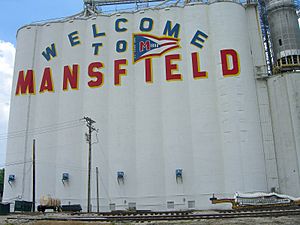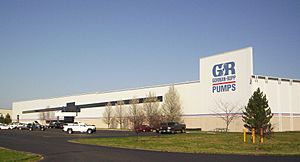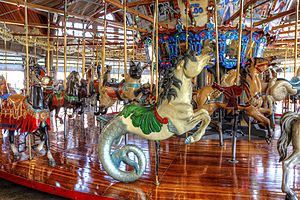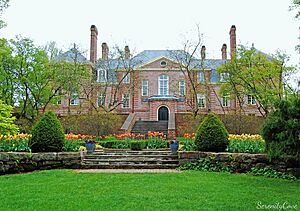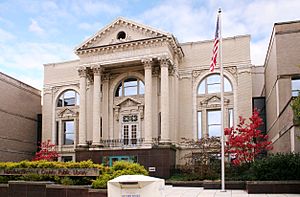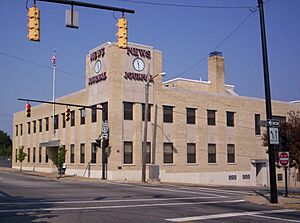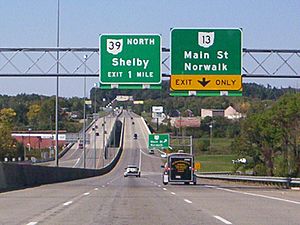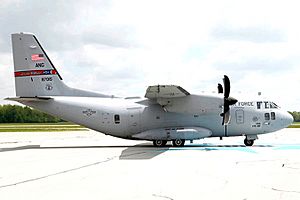Mansfield, Ohio facts for kids
Quick facts for kids
Mansfield
|
|||
|---|---|---|---|
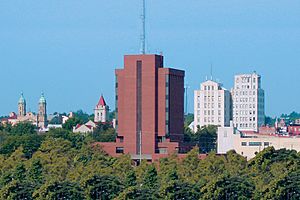
Skyline of downtown Mansfield
|
|||
|
|||
| Nickname(s):
The Field, the Queen of Ohio
|
|||
| Motto(s):
"The Heart of Ohio"
|
|||
| Country | United States | ||
| State | Ohio | ||
| County | Richland | ||
| Founded | June 11, 1808 | ||
| Incorporated | 1828 (village) | ||
| – | 1857 (city) | ||
| Named for | Jared Mansfield | ||
| Government | |||
| • Type | Mayor–council | ||
| Area | |||
| • City | 30.89 sq mi (80.01 km2) | ||
| • Land | 30.83 sq mi (79.86 km2) | ||
| • Water | 0.06 sq mi (0.15 km2) | ||
| Elevation | 1,204 ft (367 m) | ||
| Population
(2020)
|
|||
| • City | 47,534 | ||
| • Density | 1,541.66/sq mi (595.23/km2) | ||
| • Urban | 75,250 (US: 372nd) | ||
| • Metro | 124,936 (US: 322th) | ||
| • CSA | 219,408 (US: 130th) | ||
| Time zone | UTC−5 (EST) | ||
| • Summer (DST) | UTC−4 (EDT) | ||
| ZIP codes |
44900-44999
|
||
| Area code(s) | 419/567 | ||
| FIPS code | 39-47138 | ||
| GNIS feature ID | 1086879 | ||
| Website | www.ci.mansfield.oh.us | ||
Mansfield is a city in Richland County, Ohio, United States. It is the main city of the county. In 2020, about 47,534 people lived there.
The city is about 65 miles (105 km) from Cleveland and Columbus. It is located in the western hills of the Allegheny Plateau.
Mansfield was started in 1808 near the Mohican River. It grew into a big manufacturing center because many railroad lines passed through it. Today, its economy has changed. It now focuses more on services like shopping, education, and healthcare.
Mansfield is known as "The Fun Center of Ohio." It is also called the "Carousel Capital of Ohio."
Contents
History of Mansfield
How Mansfield Began
Mansfield was planned and founded in June 1808. It was named after Colonel Jared Mansfield, who was a surveyor for the United States. He helped plan the city.
The city was first laid out as a square, which is now called Central Park. In 1808, the first house was built by Samuel Martin. A year later, James Cunningham moved into the cabin. At that time, Ohio was mostly wilderness.
During the War of 1812, two blockhouses were built in the public square. These were for protection against attacks. After the war, one blockhouse was used as the first courthouse and jail until 1816. It later became a school.
Mansfield became a village in 1828. It became a city in 1857, with a population of 5,121 people. Between 1846 and 1863, railroads arrived in the city. This helped Mansfield become a center for manufacturing and trade by the late 1880s.
Many businesses made things like brass items, doors, and paper boxes. In 1888, the Ohio Brass Company started. It made brass and bronze products. By 1890, 13,473 people lived in Mansfield.
Mansfield in the 1900s and 2000s
In 1929, the old blockhouse was moved to South Park. It became a symbol of Mansfield's history.
The Mansfield Tire and Rubber Company started in 1912. It made tires for cars. In the 1920s and 1930s, Mansfield tires were as popular as big brands like Goodyear. The company grew until the 1970s. It closed in 1979, and many people lost their jobs.
In 1913, parts of Mansfield were flooded during the Great Flood of 1913. Also in 1913, the Lincoln Highway came through the city. This was the first road across America.
Oak Hill Cottage, a beautiful brick house built in 1847, was featured in a novel by local author Louis Bromfield. In 1927, the tall Leland Hotel was built downtown. It was the tallest building in Mansfield at the time.
Like many cities in the Rust Belt, Mansfield faced challenges in the 1970s and 1980s. Many manufacturing jobs were lost. However, downtown Mansfield has been improving with new businesses. In 1993, Lydia Reid became the city's first female mayor. She served for 12 years. Later, Donald Culliver became the city's first black mayor in 2007.
In 2009, Mansfield faced financial difficulties. The city recovered from these challenges by 2014.
Geography and Climate
City Landscape
Mansfield is located between Columbus and Cleveland. It is in the western hills of the Allegheny Plateau. The city has some of the highest elevations in Ohio.
The highest point in the city is about 1,493 feet (455 m) above sea level. This is at the Woodland Reservoir. Downtown Mansfield is about 1,240 feet (378 m) above sea level.
The city covers about 30.92 square miles (80.08 km2) of land. Mansfield is surrounded by several townships and the city of Ontario.
Weather in Mansfield
Mansfield has four clear seasons. This is typical for the Midwest. Winters are cold and dry, with a mix of rain, sleet, and snow. January is the coldest month. Temperatures can drop below 0 °F (−18 °C) about 5 days a year.
Snowfall averages about 49.2 inches (125 cm) per season. The biggest snowfall in 24 hours was 23 inches (58 cm) in December 2004.
Summers are usually very warm and humid. July is the warmest month. Temperatures can go above 90 °F (32 °C) about 8 days a year. Fall is often the driest season, with clear, warm days and cool nights.
Sometimes, strong Thunderstorms can happen in spring, summer, and fall. These can bring large hail or strong winds. Flooding can also occur, like in August 2007 when Mansfield received 6.24 inches (158 mm) of rain in one day.
The hottest temperature ever recorded in Mansfield was 105 °F (41 °C) on July 21, 1934. The coldest was −22 °F (−30 °C) on January 20, 1985, and January 19, 1994.
People of Mansfield
| Historical population | |||
|---|---|---|---|
| Census | Pop. | %± | |
| 1820 | 288 | — | |
| 1830 | 840 | 191.7% | |
| 1840 | 1,328 | 58.1% | |
| 1850 | 3,557 | 167.8% | |
| 1860 | 4,581 | 28.8% | |
| 1870 | 8,029 | 75.3% | |
| 1880 | 9,859 | 22.8% | |
| 1890 | 13,473 | 36.7% | |
| 1900 | 17,640 | 30.9% | |
| 1910 | 20,768 | 17.7% | |
| 1920 | 27,824 | 34.0% | |
| 1930 | 33,525 | 20.5% | |
| 1940 | 37,154 | 10.8% | |
| 1950 | 43,564 | 17.3% | |
| 1960 | 47,325 | 8.6% | |
| 1970 | 55,047 | 16.3% | |
| 1980 | 53,927 | −2.0% | |
| 1990 | 50,627 | −6.1% | |
| 2000 | 49,346 | −2.5% | |
| 2010 | 47,821 | −3.1% | |
| 2020 | 47,534 | −0.6% | |
| U.S. Decennial Census 2020 census | |||
Population in 2010
In 2010, there were 47,821 people living in Mansfield. There were 18,696 households. The city had a population density of about 1,549.1 inhabitants per square mile (598.1/km2).
Most residents (73.3%) were White. About 22.1% were African American. Other groups made up smaller percentages. Hispanic or Latino people were 1.9% of the population.
About 27.5% of households had children under 18. The average household had 2.21 people. The average family had 2.88 people. The median age in the city was 38.5 years.
Languages Spoken
In 2000, most people in Mansfield (95.98%) spoke English. Other languages spoken included Spanish (1.46%), German (1.11%), and French (0.56%). A small number of residents spoke other languages at home.
Economy and Industry
| Top Employers based in Mansfield, Ohio Source: Richland Community Development Group |
|||||
| Rank | Company/Organization | # | |||
| 1 | OhioHealth (formerly MedCentral) | 2,500 | |||
| 2 | Richland County | 1,474 | |||
| 3 | Newman Technology | 1,100 | |||
| 4 | Jay Industries | 943 | |||
| 5 | Gorman-Rupp Company | 809 | |||
| 6 | CenturyLink | 800 | |||
| 7 | Therm-O-Disc | 721 | |||
| 8 | Mansfield Board of Education | 700 | |||
| 9 | DOFASCO Corp. (Copperweld) | 666 | |||
| 10 | Mansfield Correctional Institution (MANCI) | 621 | |||
| 11 | City of Mansfield | 575 | |||
| 12 | Richland Correctional Institution (RICI) | 443 | |||
| 13 | AK Steel Corp. | 389 | |||
| 14 | School Specialty, Inc. | 381 | |||
| 15 | Walmart | 314 | |||
| 16 | Kroger | 300 | |||
| 17 | 179th Airlift Wing | 275 | |||
Mansfield was once famous for making home appliances and stoves. Westinghouse Electric Corporation was the city's largest employer in the 1950s. It had over 8,000 workers.
However, like many cities, Mansfield saw a big drop in its manufacturing jobs. Many factories closed or moved away. Today, the AK Steel plant is one of the last big industrial employers.
Mansfield has worked to make its economy more diverse. It now relies less on factories. Remaining manufacturers include AK Steel, Honda supplier Newman Technology Incorporated, and Gorman-Rupp Company which makes pumps.
The healthcare industry is also very important. OhioHealth is the city's largest employer. It is a major hospital for the area.
Mansfield is also home to three well-known food companies. Isaly Dairy Company (Isaly's) created the famous Klondike Bar ice cream treat. Stewart's Restaurants started in 1924 and is known for its root beer. The Jones Potato Chip Company, started in 1945, makes Jones Marcelled Potato Chips.
Mansfield in Movies
Mansfield has been a filming location for several Hollywood movies. The old Ohio State Reformatory has been used as a backdrop in many films. These include The Shawshank Redemption, Air Force One, and Tango & Cash.
Robert F. Simon, a famous actor who appeared in many films and TV shows, was born in Mansfield.
Arts and Culture
Events and Festivals
The Mansfield/Mehock Relays is an annual track and field event for high school students. It has been held every April since 1927.
The Miss Ohio Pageant is held every year in Mansfield at The Renaissance. This event helps choose Ohio's representative for the Miss America competition.
The Richland County Fair is also held in Mansfield every August. It started in 1849. The fair has rides, animal judging, and other fun activities.
Historic Places and Museums
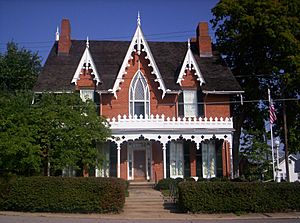
Mansfield is home to the old Ohio State Reformatory. This building looks like a German castle. It was built between 1886 and 1910. It has been used in many major films, including The Shawshank Redemption.
Most of the prison yard is gone now. But the main building, with its Gothic style, is still standing. It is a popular place for tourists. During Halloween, it becomes a "Haunted Reformatory."
The Mansfield Memorial Museum is located downtown. It was built in 1887 and opened in 1889. It has many different exhibits.
Oak Hill Cottage is a beautiful brick house built in 1847. It is run by the Richland County Historical Society. The Mansfield Art Center, opened in 1945, focuses on visual arts. BibleWalk is Ohio's only life-size wax museum.
Performing Arts
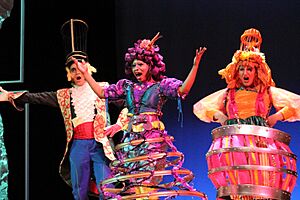
Downtown Mansfield has many attractions and arts venues. Concerts at the Brickyard venue can attract thousands of people.
The Renaissance Performing Arts Association performs at the historic Renaissance Theatre. They put on Broadway-style shows, classical music, comedy, and family events. The Renaissance Theatre is also home to the Mansfield Symphony Orchestra.
Mid-Ohio Opera is an opera company based in downtown Mansfield. They perform operas and classical vocal concerts.
The Mansfield Playhouse, founded in 1929, is one of Ohio's oldest community theaters.
Parks and Fun Activities
Mansfield has 33 parks. They range in size from small neighborhood parks to the 35-acre (140,000 m2) South Park. There are also several public golf courses nearby.
The Richland Carousel Park opened in 1991. It is in downtown Mansfield. It was the first hand-carved indoor wooden carousel built in the United States since the 1930s.
Kingwood Center is a 47-acre (19 ha) estate and gardens. It was once the home of Charles Kelly King, an industrialist. Snow Trails Ski Resort is Ohio's oldest ski resort. It opened in 1961 and is one of the few places to go skiing in Ohio.
The Richland B&O Bike Trail opened in 1995. It is a paved 18.3-mile (29.5 km) trail for hiking and biking. It follows an old railroad line.
Education in Mansfield
Mansfield Public Schools serve over 4,500 students. The district has 8 public schools, including elementary, middle, and high schools. There is also a Spanish immersion school.
The city also has private schools. These include two Catholic schools, St. Mary's Catholic School and St. Peter's High School. There are also two Christian schools, Mansfield Christian School and Temple Christian School. Discovery School is a private school that offers the International Baccalaureate program.
Mansfield is home to three colleges. Ohio State University has a regional campus here. North Central State College is a community college that shares the campus with OSU. Ashland University's Dwight Schar College of Nursing & Health Sciences offers nursing programs.
Libraries for Learning
The Mansfield/Richland County Public Library (M/RCPL) has been helping people since 1887. It has nine branches throughout Richland County. The main library is in downtown Mansfield.
Media and News
Print News
Mansfield has a daily newspaper called the Mansfield News Journal. There is also a digital newspaper called the Richland Source.
TV and Radio
The Mid-Ohio region, which includes Mansfield, has one local TV station, WMFD-TV 68. It provides local news and high school sports. Mansfield also receives TV signals from Cleveland and Columbus.
There are 16 radio stations that serve the Mansfield area. These include music stations playing different styles like adult contemporary and country. There are also news/talk stations and sports radio stations.
Getting Around Mansfield
Roads and Highways
Mansfield is on a major east-west highway route. In the early 1900s, this was part of the historic Lincoln Highway. This was the first road across America. The Lincoln Highway helped Mansfield grow a lot.
Today, this route is U.S. Route 30. It is also called the Martin Luther King Jr. Freeway. Interstate 71 also connects Mansfield to cities like Columbus and Cleveland.
There are also other important roads like U.S. Route 42 and Ohio State Route 13. Some roads have special routes for large trucks to avoid low bridges downtown.
Public Transport
The Richland County Transit (RCT) runs local bus services five days a week. They have 9 routes in Mansfield and nearby areas. There are also taxi services available 24 hours a day.
Airports and Trains
Mansfield Lahm Regional Airport is located 3 miles (4.8 km) north of downtown. The 179th Airlift Wing of the Ohio Air National Guard is based at this airport. They use large C-130 aircraft and host an annual air show.
Mansfield is located between John Glenn Columbus International Airport and Cleveland Hopkins International Airport. These airports offer commercial flights.
Three railroads used to serve Mansfield. Now, only two, the Norfolk Southern and the Ashland Railway, provide service. Part of an old railroad line is now the Richland B&O Trail, a popular bike path.
Interesting Facts
- Johnny Appleseed, a famous American pioneer, is thought to be from Mansfield.
Sister Cities
Mansfield has friendly relationships with these cities:
 – Mansfield, Nottinghamshire, United Kingdom
– Mansfield, Nottinghamshire, United Kingdom – Tamura, Fukushima, Japan
– Tamura, Fukushima, Japan
See also
 In Spanish: Mansfield (Ohio) para niños
In Spanish: Mansfield (Ohio) para niños






